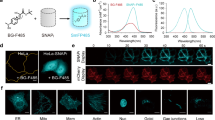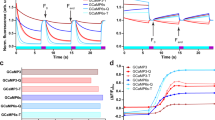Abstract
We constructed a fluorescent sensor of adenylate nucleotides by combining a circularly permuted variant of GFP with a bacterial regulatory protein, GlnK1, from Methanococcus jannaschii. The sensor's affinity for Mg-ATP was <100 nM, as seen for other members of the bacterial PII regulator family, a surprisingly high affinity given that normal intracellular ATP concentration is in the millimolar range. ADP bound the same site of the sensor as Mg-ATP, competing with it, but produced a smaller change in fluorescence. At physiological ATP and ADP concentrations, the binding site is saturated, but competition between the two substrates causes the sensor to behave as a nearly ideal reporter of the ATP:ADP concentration ratio. This principle for sensing the ratio of two analytes by competition at a high-affinity site probably underlies the normal functioning of PII regulatory proteins. The engineered sensor, Perceval, can be used to monitor the ATP:ADP ratio during live-cell imaging.
This is a preview of subscription content, access via your institution
Access options
Subscribe to this journal
Receive 12 print issues and online access
$259.00 per year
only $21.58 per issue
Buy this article
- Purchase on Springer Link
- Instant access to full article PDF
Prices may be subject to local taxes which are calculated during checkout






Similar content being viewed by others
Change history
11 January 2009
NOTE: In the version of this article initially published online, the labels indicating glucose removal in Figure 6 were misaligned. This error has been corrected for the print, PDF and HTML versions of this article.
References
Ashcroft, F.M. & Gribble, F.M. ATP-sensitive K+ channels and insulin secretion: their role in health and disease. Diabetologia 42, 903–919 (1999).
Dennis, P.B. et al. Mammalian TOR: a homeostatic ATP sensor. Science 294, 1102–1105 (2001).
Weiss, J.N. & Lamp, S.T. Cardiac ATP-sensitive K+ channels. Evidence for preferential regulation by glycolysis. J. Gen. Physiol. 94, 911–935 (1989).
Hoffman, J.F. ATP compartmentation in human erythrocytes. Curr. Opin. Hematol. 4, 112–115 (1997).
Wilson, T. & Hastings, J.W. Bioluminescence. Annu. Rev. Cell Dev. Biol. 14, 197–230 (1998).
Kennedy, H.J. et al. Glucose generates sub-plasma membrane ATP microdomains in single islet beta-cells. Potential role for strategically located mitochondria. J. Biol. Chem. 274, 13281–13291 (1999).
Bell, C.J., Manfredi, G., Griffiths, E.J. & Rutter, G.A. Luciferase expression for ATP imaging: application to cardiac myocytes. Methods Cell Biol. 80, 341–352 (2007).
Baird, G.S., Zacharias, D.A. & Tsien, R.Y. Circular permutation and receptor insertion within green fluorescent proteins. Proc. Natl. Acad. Sci. USA 96, 11241–11246 (1999).
Nagai, T., Sawano, A., Park, E.S. & Miyawaki, A. Circularly permuted green fluorescent proteins engineered to sense Ca2+. Proc. Natl. Acad. Sci. USA 98, 3197–3202 (2001).
Belousov, V.V. et al. Genetically encoded fluorescent indicator for intracellular hydrogen peroxide. Nat. Methods 3, 281–286 (2006).
Ninfa, A.J. & Jiang, P. PII signal transduction proteins: sensors of alpha-ketoglutarate that regulate nitrogen metabolism. Curr. Opin. Microbiol. 8, 168–173 (2005).
Durand, A. & Merrick, M. In vitro analysis of the Escherichia coli AmtB-GlnK complex reveals a stoichiometric interaction and sensitivity to ATP and 2-oxoglutarate. J. Biol. Chem. 281, 29558–29567 (2006).
Yildiz, O., Kalthoff, C., Raunser, S. & Kühlbrandt, W. Structure of GlnK1 with bound effectors indicates regulatory mechanism for ammonia uptake. EMBO J. 26, 589–599 (2007).
Ereciñska, M. & Silver, I.A. Ions and energy in mammalian brain. Prog. Neurobiol. 43, 37–71 (1994).
Wolfe, D.M., Zhang, Y. & Roberts, G.P. Specificity and regulation of interaction between the PII and AmtB1 proteins in Rhodospirillum rubrum. J. Bacteriol. 189, 6861–6869 (2007).
Jiang, P. & Ninfa, A.J. Escherichia coli PII signal transduction protein controlling nitrogen assimilation acts as a sensor of adenylate energy charge in vitro. Biochemistry 46, 12979–12996 (2007).
Atkinson, D.E. The energy charge of the adenylate pool as a regulatory parameter. Interaction with feedback modifiers. Biochemistry 7, 4030–4034 (1968).
Hardie, D.G., Salt, I.P., Hawley, S.A. & Davies, S.P. AMP-activated protein kinase: an ultrasensitive system for monitoring cellular energy charge. Biochem. J. 338, 717–722 (1999).
Nilsson, T., Schultz, V., Berggren, P.O., Corkey, B.E. & Tornheim, K. Temporal patterns of changes in ATP/ADP ratio, glucose 6-phosphate and cytoplasmic free Ca2+ in glucose-stimulated pancreatic beta-cells. Biochem. J. 314, 91–94 (1996).
DeVivo, D.C., Leckie, M.P., Ferrendelli, J.S. & McDougal, D.B. Chronic ketosis and cerebral metabolism. Ann. Neurol. 3, 331–337 (1978).
Folbergrová, J., Minamisawa, H., Ekholm, A. & Siesjö, B.K. Phosphorylase alpha and labile metabolites during anoxia: correlation to membrane fluxes of K+ and Ca2+. J. Neurochem. 55, 1690–1696 (1990).
Veech, R.L., Lawson, J.W., Cornell, N.W. & Krebs, H.A. Cytosolic phosphorylation potential. J. Biol. Chem. 254, 6538–6547 (1979).
Mörikofer-Zwez, S. & Walter, P. Binding of ADP to rat liver cytosolic proteins and its influence on the ratio of free ATP/free ADP. Biochem. J. 259, 117–124 (1989).
Koretsky, A.P., Brosnan, M.J., Chen, L.H., Chen, J.D. & Dyke, T.V. NMR detection of creatine kinase expressed in liver of transgenic mice: determination of free ADP levels. Proc. Natl. Acad. Sci. USA 87, 3112–3116 (1990).
Chiuman, W. & Li, Y. Simple fluorescent sensors engineered with catalytic DNA 'MgZ' based on a non-classic allosteric design. PLoS ONE 2, e1224 (2007).
Huizenga, D.E. & Szostak, J.W.A. DNA aptamer that binds adenosine and ATP. Biochemistry 34, 656–665 (1995).
Willemse, M., Janssen, E., de Lange, F., Wieringa, B. & Fransen, J. ATP and FRET–a cautionary note. Nat. Biotechnol. 25, 170–172 (2007).
Kiang, J.G., McKinney, L.C. & Gallin, E.K. Heat induces intracellular acidification in human A-431 cells: role of Na(+)-H+ exchange and metabolism. Am. J. Physiol. 259, C727–C737 (1990).
Brown, S.E., Heming, T.A., Benedict, C.R. & Bidani, A. ATP-sensitive Na(+)-H+ antiport in type II alveolar epithelial cells. Am. J. Physiol. 261, C954–C963 (1991).
Nagai, T. et al. A variant of yellow fluorescent protein with fast and efficient maturation for cell-biological applications. Nat. Biotechnol. 20, 87–90 (2002).
Acknowledgements
We thank T. Abramson for expert technical assistance with the molecular biology, A. Miyawaki (RIKEN Brain Science Institute) for sending the original plasmid encoding Venus, O. Yildiz and W. Kühlbrandt (Max Planck Institute of Biophysics, Frankfurt am Main) for sending the original plasmid encoding GlnK1, M. Merrick (John Innes Centre) for sending bacterial strains and members of the Yellen lab for their comments and discussion. This work was supported by research grants from the US National Institutes of Health –National Institute of Neurological Disorders and Stroke (NS029693 and NS055031) to G.Y.
Author information
Authors and Affiliations
Contributions
G.Y. and J.B. designed the research; G.Y., J.B. and Y.P.H. conducted experiments and wrote the paper.
Corresponding author
Supplementary information
Supplementary Text and Figures
Supplementary Figures 1–10, Supplementary Results, Supplementary Methods (PDF 806 kb)
Rights and permissions
About this article
Cite this article
Berg, J., Hung, Y. & Yellen, G. A genetically encoded fluorescent reporter of ATP:ADP ratio. Nat Methods 6, 161–166 (2009). https://doi.org/10.1038/nmeth.1288
Received:
Accepted:
Published:
Issue Date:
DOI: https://doi.org/10.1038/nmeth.1288
This article is cited by
-
AMPK is a mechano-metabolic sensor linking cell adhesion and mitochondrial dynamics to Myosin-dependent cell migration
Nature Communications (2023)
-
Colorimetric Detection of ATP by a Chlorophosphonazo III -based Mg2+ Complex in Aqueous Solution via Indicator Displacement Approach
Journal of Fluorescence (2023)
-
Using genetically encoded fluorescent biosensors to interrogate ovarian cancer metabolism
Journal of Ovarian Research (2022)
-
Mutations in respiratory complex I promote antibiotic persistence through alterations in intracellular acidity and protein synthesis
Nature Communications (2022)
-
Energy matters: presynaptic metabolism and the maintenance of synaptic transmission
Nature Reviews Neuroscience (2022)



